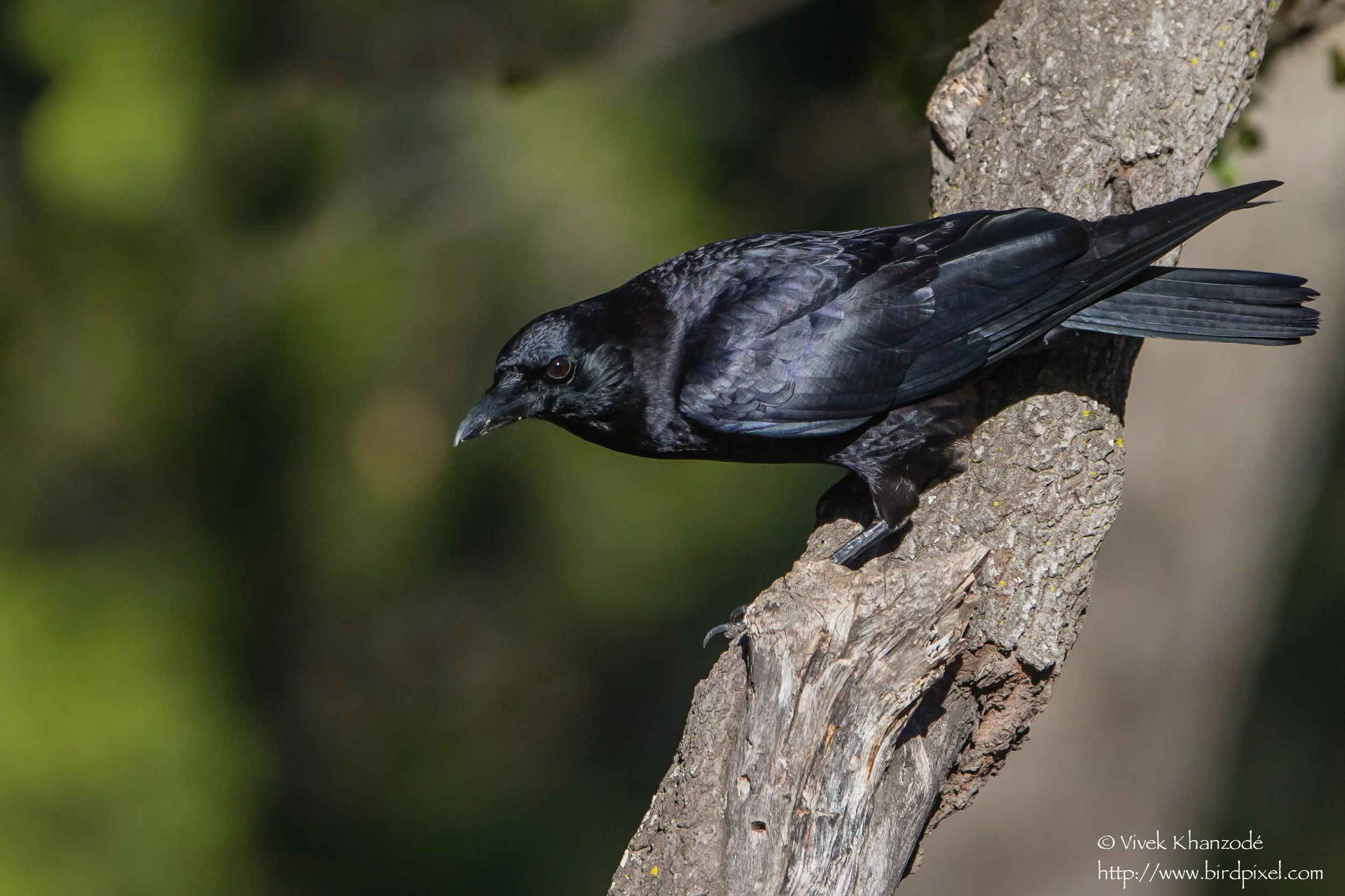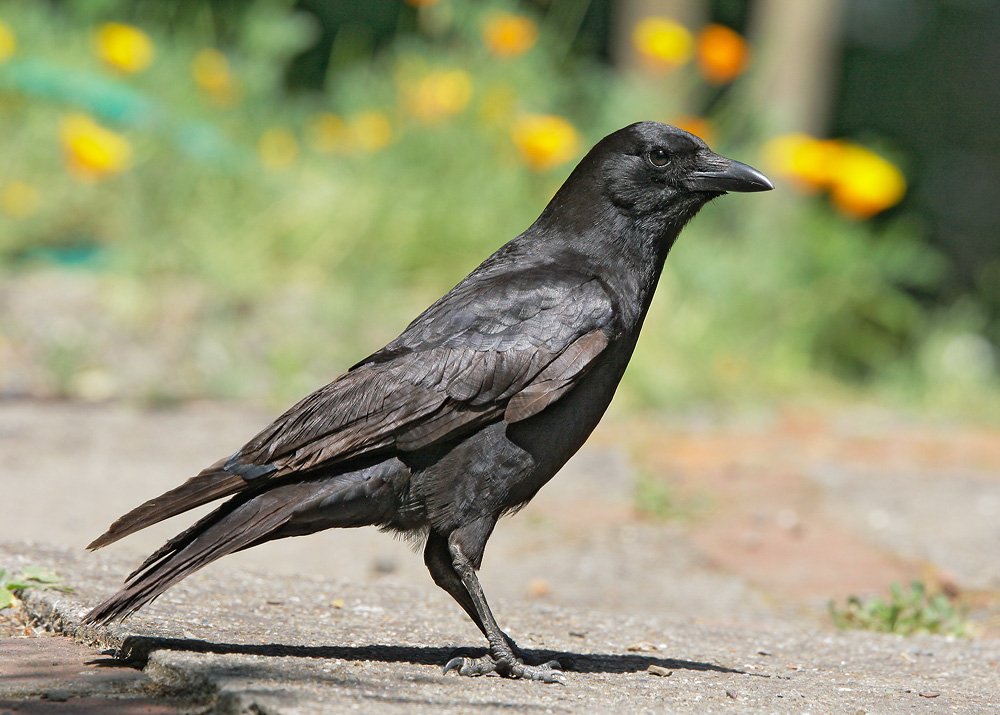American Crow
BY DAVE ZITTIN
The American Crow has to be the most difficult backyard bird to write about because there have been so many interesting studies on this species. The goal of this article is to introduce you to the American Crow and hopefully make you want to learn more on your own.
American Crow. Note the brown feathers. Photo by Tom Grey
When I was a grad student, we spent summers in a small fishing village on the West Coast of Vancouver Island, where we frequently heard a metallic “bong” or “boing” sound similar to that of a rapidly released metal spring. The sound came from within a dense conifer forest, and we spent months looking for its source. Eventually, we found it: a Northwestern Crow. (Recent research has folded the Northwestern Crow into the American Crow, so the Northwestern Crow no longer exists as an independent species.) Crows can mimic sounds of other species including the human voice, so the boing sound we heard could have been a mimic of some unknown sound.
American Crow by Brooke Miller
American Crows are highly-adaptable opportunistic feeders consuming seeds, marine, and terrestrial invertebrates, eggs, nestlings of other bird species, turtles, small rodents, fruit, road-kill, garbage, and more. Once, we had American Crows feast on bags of groceries we were transporting by boat. They quickly found our cheese packages, and during the seconds we were away from the boat carrying bags into the house, they excavated the cheese blocks remaining on the boat. This species is extremely intelligent and will sometimes cooperate when it comes to acquiring food. In one case, American Crows were observed taking a fish from a river otter. One pecked at its tail, causing the otter to drop the fish, while the other crow grabbed the fish and flew off to a perch where they both had a feast. American Crows are often mobbed by other bird species who are protecting their eggs and young from this predator. American Crows will eat carrion, but their beaks aren’t strong and sharp enough to pierce the skin of a dead animal, so they must wait for a better-equipped carrion feeder to break the skin. Crows will also carry turtles, nuts, clams, etc. into the air and drop them on hard surfaces to crack them open.
American Crows congregating by John Scharpen
American Crows are social. Family groups of up to 15 individuals stay together, and sibs from previous hatches help raise younger brothers and sisters. Outside the breeding season, large numbers of American Crows come together to roost at night. These roosts can consist of tens of thousands of individuals and can be quite annoying to nearby people.
American Crows damage some crops. It is legal to hunt and kill this species in some areas of the United States. However, evidence suggests that American Crows may benefit corn crops by eating pest insects that overwinter in the corn stubble.
Crows have an uncanny ability to recognize human faces and will distinguish good people from bad (see behavior video in the explore section).
Attracting Crows to Backyards
I don’t go out of my way to attract them, but they do show up infrequently to eat the bird seed mix I spread on the ground.
Description
A large, black bird with a large black beak, black feet, and black legs. Their feathers have a slight iridescent sheen. The body feathers of molting individuals take on a brown coloring. The Latin species name of the American Crow is brachyrhynchos. Brachyrhynchos is Latin for “short-beaked.” This name is confusing to me because many other members of the same genus, Corvus, have beaks that are as short as the American Crow’s. Compared with the Common Raven (same genus), there is no question that the crow’s beak is shorter. Perhaps this is the reason.
Notice the squared-off tail end of this American Crow. Photo by Vivek Khanzodé
Distribution
The American Crow is found throughout the year over much of the United States, along the west coast of North America, and west into the Aleutian Islands. They also occur across much of southern Canada in the breeding season. They will live almost anywhere there is a food source and some trees on which to nest and perch. They tend to avoid deserts.
Similar Species
The Common Raven and the American Crow are similar at first glance. Paying attention to a few differences can help determine which species you are viewing. In flight, Common Ravens exhibit long glides and can soar in thermals. American Crows exhibit short glides and flap their wings more than Common Ravens. They do not soar in thermals. You will often read that the Common Raven’s tail is wedge or diamond-shaped in flight and the American Crow’s tail lacks this diamond shape. Be careful with this difference because as crows land or fly in a slow, steep turn, they splay their tails, giving them a wedged-shaped appearance.
American Crow in flight by John Scharpen. Note the shorter fan-shaped tail.
Common Raven in flight by John Scharpen. Note the diamond-shaped tail.
American Crows and Common Ravens make different sounds. Typically the adult Raven makes a guttural “gawk” sound, and the adult American Crow usually makes its trademark “caw” sound. A roosting American Crow bobs its head down then up as it vocalizes and sometimes slightly opens its wings. A vocalizing Common Raven is relatively still. The throat and head of the Common Raven are often fluffed or ruffled; those of the American Crow are usually smooth.
Common Raven with fluffed throat and head by Dave Zittin
The Fish Crow of the south and eastern parts of the United States looks very much like the American Crow. They can be told apart by sight and sound.
Explore
To explore American Crows in more detail, I recommend the following videos:
Crow “boing” sound from the Urban Nature Enthusiast. Note the strong bobbing when they vocalize.
Excellent video on American Crow behavior from Lesley the Bird Nerd. Note bobbing while vocalizing at 3:11 and 8:53
Common Raven versus American Crow from the Raven Diaries
More Backyard Bird Information
View more common Santa Clara County Backyard Birds
Visit our Backyard Birding page
Tell us what you’re seeing in your yard! Send your notes, photos, and sound clips to backyardbirds@scvas.org. We’ll feature your submittals on our website.
Banner Photo: Vivek Khanzodé








